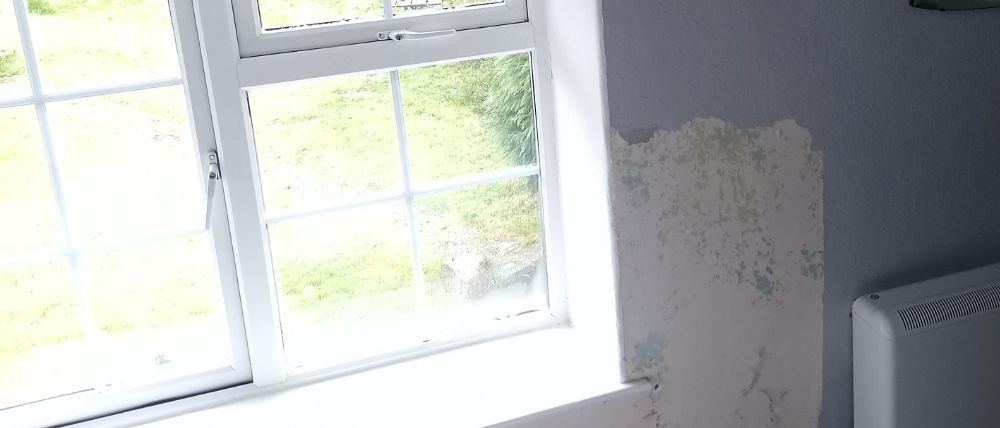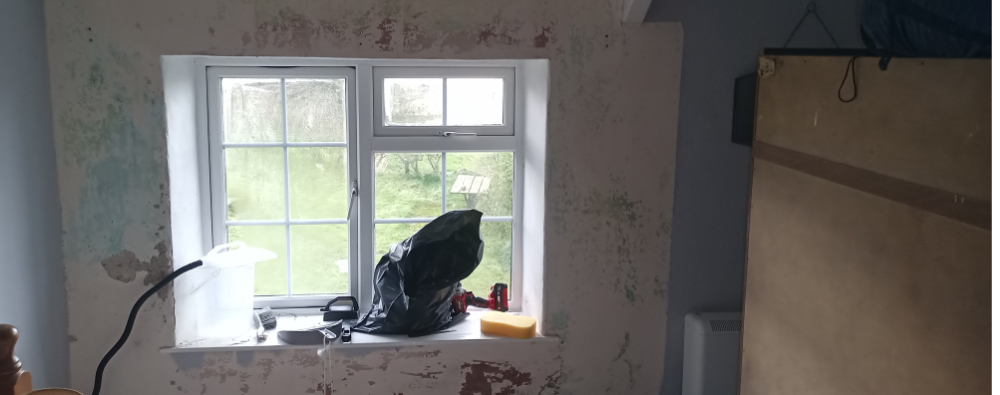Lime based thermal plaster part 1
Contents |
[edit] Brief intro
This is the first part of a short blog, experimenting with applying a known thermal lime plaster product internally. It is a 2 part article, the second of which can be found under Lime based thermal plaster part 2. It describes testing a product above and beyond the advice given by the manufacturer, which is not recommended. However, in this case, options were limited, and it was done with some knowledge of the risks involved.
[edit] Context
This project is in an old house with solid granite stone walls approximately 500 mm thick, with no kind of membrane as it was built in around 1600. The external faces of the building have been rendered, initially with lime but then probably with a cement mortar mix in the 70s–80s. The internal face of the front wall is exposed stonework with sand and cement pointing from the same period. The rear wall and the wall that is the focus of this project, internally had primarily the original lime plaster, with areas of patch gypsum plastering, particularly around the windows and elsewhere. It has had many layers of paint work over the years, most likely non-breathing paint, with the most recent finish being glue and then a patterned wall paper.
The cottage is rented as a holiday let. The room has always been cold and the rear wall always damp, and each year the wall paper needed to be stuck back down. The reasons are assumed to be partly because it is a first-floor wall and very exposed to driving rain and wind (costal location), and possibly because it has quite minimal overhangs at the eaves (historically, it was originally thatch), and there may be issues with the condition and size of gutters. The house is heated with night storage heaters, and although the loft has been insulated, the low eaves mean the pitch at the tops of the walls internally has minimal insulation, if any, as the other side is the ventilation space under the roof.
[edit] Limitations
In terms of the wall, the understanding is that the correct way and proper way to renovate it, would be to remove all the external and internal mixed lime and concrete render to expose the stonework, clear any cement mortar and start from scratch with lime-based products. Perhaps with a cost-effective hemp product; however, due to time and cost restrictions, as well as practicality ( scaffolding required etc ) this would most likely never be done. One option would be to remove the plaster internally, start again with lime, and then do the external face later, but again, time restricts this. Having looked at the variety of insulating plasters it was decided to stay away from organic-based materials, such as hemp shiv, cork, etc. because of the continued risk of damp in the wall and the potential to lead to rot with the organic materials. So all these elements considered, the options seemed to point towards a mineral-based solution, which in theory implies less risk associated with rotting, such as perlite, and a lime based product with a potentially greater threshold to cope with some damp issues, if there are any persisting, but improving thermally efficiency as well as breathability, at least internally.
Another challenge had been drying time, because, as a holiday let, the warmer periods are primary rental times, and the windows in between bookings can be short. Many lime-based products take time to dry and, as such, often can’t be quick in and out fix. Though this varies considerably with hydraulic and non-hydraulic lime, it also varies, it seems, with individual products. One lime-based product researched seemed to have a similar drying time to gypsum and offered a mineral based thermally insulating product, so I investigated further. Convinced of the drying time, and after speaking on the phone, the advice was familiar: to ideally remove all internal plasterwork, all render, and start from scratch. They offered three products: a thermal product, a hemp-based product, and a finished lime coat, all with similar drying times depending on thickness.
Knowing it wouldn’t be possible able to follow their recommendations entirely, but knowing the risks involved, it was decided to test and see if based on the above the plan of action would be okay, knowing risks and expectations. Knowing also the chances of having a dry surface to paint on in time were unlikely, meant earmarking the possibility of using pigments to speed things up, though this was also, clearly and understandably not recommended by the supplier. This is all being very sensible because manufacturers need to be 100% sure their product will function as advertised, and adding pigments or unspecified aspects can inevitably change performance. None the less progression was made with this essentially un recommended approach, a kin to to testing the product beyond its specification and seeing where the project managed to get to in the three weeks before the next guests were due to arrive. The thought of sticking down wall paper for yet another year and filling it with gypsum just didn’t make sense, so though not perfect, it seemed the better of the options on offer, even if not taking the best advice, and perhaps not the 'correct' way as such.
[edit] Related articles on Designing Buildings
- Binding agent.
- Cement mortar.
- Defects in brickwork.
- Defects in stonework.
- Dry hydrate lime mortar.
- Grout.
- Gypsum.
- Harl.
- Hemp lime construction: A guide to building with hemp lime composites.
- High alumina cement.
- High lime low alkali glass.
- Hot-mixed lime mortar.
- Hot-mixed mortars: the new lime revival.
- Hydraulic lime.
- Hydrated lime.
- Lime concrete.
- Lime mortar.
- Lime mortars vs. cement.
- Lime plaster.
- Lime putty mortar.
- Lime run-off.
- Mortar.
- Mortar analysis for specifiers.
- Non hydraulic lime.
- Pointing.
- Portland cement.
- Rendering.
- Soda-lime glass.
- Stucco.
- Types of mortar.
- The use of lime mortar in building conservation.
- Types of mortar.
Featured articles and news
CIOB and CORBON combine forces
To elevate professional standards in Nigeria’s construction industry.
Amendment to the GB Energy Bill welcomed by ECA
Move prevents nationally-owned energy company from investing in solar panels produced by modern slavery.
Gregor Harvie argues that AI is state-sanctioned theft of IP.
Heat pumps, vehicle chargers and heating appliances must be sold with smart functionality.
Experimental AI housing target help for councils
Experimental AI could help councils meet housing targets by digitising records.
New-style degrees set for reformed ARB accreditation
Following the ARB Tomorrow's Architects competency outcomes for Architects.
BSRIA Occupant Wellbeing survey BOW
Occupant satisfaction and wellbeing tool inc. physical environment, indoor facilities, functionality and accessibility.
Preserving, waterproofing and decorating buildings.
Many resources for visitors aswell as new features for members.
Using technology to empower communities
The Community data platform; capturing the DNA of a place and fostering participation, for better design.
Heat pump and wind turbine sound calculations for PDRs
MCS publish updated sound calculation standards for permitted development installations.
Homes England creates largest housing-led site in the North
Successful, 34 hectare land acquisition with the residential allocation now completed.
Scottish apprenticeship training proposals
General support although better accountability and transparency is sought.
The history of building regulations
A story of belated action in response to crisis.
Moisture, fire safety and emerging trends in living walls
How wet is your wall?
Current policy explained and newly published consultation by the UK and Welsh Governments.
British architecture 1919–39. Book review.
Conservation of listed prefabs in Moseley.
Energy industry calls for urgent reform.




























